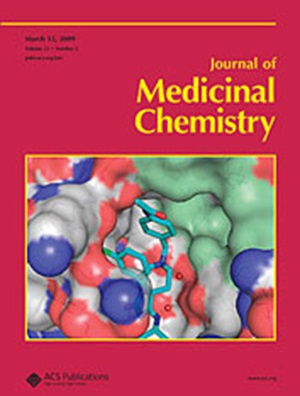Synthesis of an RBM39 Degrader That Downregulates CEP192 and Induces Disorganized Spindle Structures
IF 6.8
1区 医学
Q1 CHEMISTRY, MEDICINAL
引用次数: 0
Abstract
RBM39 is an essential component of the spliceosome, playing a critical role in maintaining mRNA integrity. Its depletion significantly exacerbates RNA splicing defects and demonstrates potent anticancer activity. To identify key effectors following RBM39 depletion, we employed a multiomics approach to directly compare two structurally distinct compounds, CB039 and Indisulam. Through proteomic analysis, RNA sequencing, and DepMap dependency assessment, CEP192 emerged as a crucial gene, exhibiting dependency in 96% of the 1,100 analyzed cancer cell lines. In eight cancer cell lines, treatment with both CB039 and Indisulam consistently induced CEP192 exon 42 skipping and reduced CEP192 protein levels. Mechanistically, either CB039 treatment or RNA interference-mediated CEP192 knockdown led to a significant increase in spindle disorganization, as well as chromosome condensation and failed segregation. In conclusion, our characterization of the downstream effects of RBM39 depletion provides novel insights into the therapeutic potential of RBM39 degraders.

下调CEP192并诱导无序纺锤体结构的RBM39降解物的合成
RBM39是剪接体的重要组成部分,在维持mRNA完整性方面发挥关键作用。它的缺失显著加剧了RNA剪接缺陷,并显示出有效的抗癌活性。为了确定RBM39耗竭后的关键效应物,我们采用多组学方法直接比较了两种结构不同的化合物CB039和吲哚兰。通过蛋白质组学分析、RNA测序和DepMap依赖性评估,CEP192成为了一个关键基因,在1100个分析的癌细胞系中,有96%的癌细胞系都表现出依赖性。在8种癌细胞系中,CB039和茚二唑仑均可诱导CEP192外显子42跳变,并降低CEP192蛋白水平。从机制上讲,CB039处理或RNA干扰介导的CEP192敲低导致纺锤体解体、染色体凝聚和分离失败的显著增加。总之,我们对RBM39缺失的下游效应的描述为RBM39降解物的治疗潜力提供了新的见解。
本文章由计算机程序翻译,如有差异,请以英文原文为准。
求助全文
约1分钟内获得全文
求助全文
来源期刊

Journal of Medicinal Chemistry
医学-医药化学
CiteScore
4.00
自引率
11.00%
发文量
804
审稿时长
1.9 months
期刊介绍:
The Journal of Medicinal Chemistry is a prestigious biweekly peer-reviewed publication that focuses on the multifaceted field of medicinal chemistry. Since its inception in 1959 as the Journal of Medicinal and Pharmaceutical Chemistry, it has evolved to become a cornerstone in the dissemination of research findings related to the design, synthesis, and development of therapeutic agents.
The Journal of Medicinal Chemistry is recognized for its significant impact in the scientific community, as evidenced by its 2022 impact factor of 7.3. This metric reflects the journal's influence and the importance of its content in shaping the future of drug discovery and development. The journal serves as a vital resource for chemists, pharmacologists, and other researchers interested in the molecular mechanisms of drug action and the optimization of therapeutic compounds.
 求助内容:
求助内容: 应助结果提醒方式:
应助结果提醒方式:


